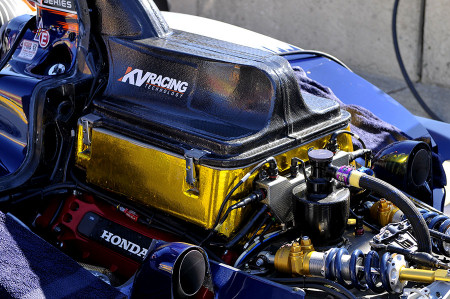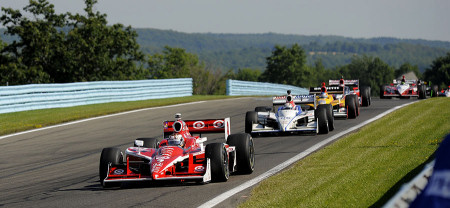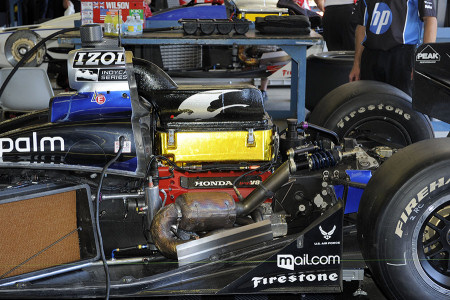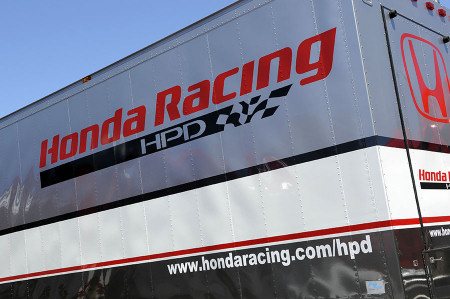The Way It Is/ Honda's turbo V6 begins to take shape
by Gordon Kirby As reported in this space in April over the past two years Honda has been developing a new 2.4 liter twin turbo V6 engine for IndyCar and ALMS racing. Honda's new V6 will form the basis of IndyCar's 2012 formula and will also race as a customer engine in the ALMS's P2 category. Honda settled on pursuing a turbo V6 for both Indy car and sports car racing two years ago but serious design and simulation work didn't start until last year.
As reported in this space in April over the past two years Honda has been developing a new 2.4 liter twin turbo V6 engine for IndyCar and ALMS racing. Honda's new V6 will form the basis of IndyCar's 2012 formula and will also race as a customer engine in the ALMS's P2 category. Honda settled on pursuing a turbo V6 for both Indy car and sports car racing two years ago but serious design and simulation work didn't start until last year.
"Our design started in earnest back in the fall of 2009," said Honda Performance Development's president Erik Berkman. "We went through a lot of iterations on paper. We had a design concept in mind back in 2008 but we uncorked our resources in the fall of ‘09 to put a little more serious effort into this post-works era in the ALMS. We had to put our attention into something and with the sports car era turning more to customer programs we wanted to work on the belief that we were going to get this new IndyCar engine done.
"Developing new things and new products are a way of life for us," Berkman added. "We've got these people who are brought together for a purpose and if they don't have a purpose they don't want to be there anymore. They want to go work for somebody else. So we had to commit to a new development program to keep their interest and focus."
Last winter Honda began to pressure the IRL for a commitment to a new V6 engine formula. But Berkman says his company backed-off a little with the appearance in February of the Delta Wing Indy car concept and Randy Bernard's arrival in March as the IRL's new CEO.
"By the time we got to 2010, not knowing that Randy was coming, we were pushing very hard and trying to get the League to make a firm and absolute commitment," Berkman commented. "We were pretty close in January of this year. Then with the Delta Wing's appearance and the League's decision to solicit the chassis manufacturers to come out and formally submit their plans the engine planning went a little bit on the backburner.

© Gary Gold
"I think the final formal rules package won't be out for a little while," Berkman added. "I think at the chassis announcement on the 14th there will be some high level bullets of the fundamental decision that has been made related primarily to chassis. I don't know that the details of the engine or chassis rules will come out then. It's probably going to take another six weeks. As far as the chassis is concerned I don't know what the conclusion's going to be."
Honda has not made much progress in recent months on the development of its new V6 but is ready to ramp up the development phase.
"From the first of February through Indy we were more or less marching in place," Berkman remarked. "We weren't moving forward, but we weren't going backwards. At what point was it going to be firm enough for us to leap off the cliff and start spending real money?
"When I met Randy for the first time he told me point blank that he needed ninety days or three months to get his arms around what he had. I said, okay I think that's fair. I know how steep the learning curve is, so I wanted to be a reasonable person. I said I was going to march in place and tell my guys to double and triple check their calculations and their design in the virtual world.
"So I stayed in close contact with Randy and had always been in close contact with Brian (Barnhart) and others at the League. We had a design and we are now marching forward as opposed to marking time. I don't want to be to specific about when we're going to be on the dyno and when we'll be producing a targeted power output and targeted life. We'll have some kind of a coming out party later in time, but we're moving forward."
Berkman is happy with the process that determined IndyCar's 2012 rules.
"We've been in constant dialogue with the League," Berkman said. "It's not a start-stop thing. For many months now we've had a draft set of rules in front of us from the League, working with Les McTaggart. Roger Griffiths is our primary leader or Large Project Leader and is our primary liaison with the League working through Les and Brian. We've had this draft rules package which has been shopped around and provided to other engine manufacturers. To some extent Honda has shown some leadership in that regard but we can't take sole responsibility because many of the concepts and ideas in the rules came from Audi or Fiat or whoever was involved in the round table process in 2008.
"The original tenets of that round table were that the way for manufacturers to be controlled is through the rules, and they way for us to be prevented from spending stupid money is through the rules. So we want the rules-making body to have a firm hand and not pull its punches in many areas of the rules. Then in other areas of the rules we want it to be more open. So allow us areas where we can go and play and then prevent us from playing in other areas that will save a lot of money. And all the manufacturers have echoed a hearty round of hear-hears."
Berkman wants to see serious restrictions placed on the use of ultra-lightweight, friction-reducing materials.
"There has to be a list of banned materials or limited application of specific exotic materials," he observed. "There has to be certain elements, whether they be some kind of dimension or what have you, that prevent the purusit of hyper lightweight materials or some new, innovative process in the pursuit of the lowest possible inertia or weight. You've got to make the minimum weight or CG relatively fat, dumb and lazy, so to speak. Then we won't be able to go there.

© Gary Gold
Berkman reflected briefly on the high-consumption era Honda enjoyed a few years ago in CART and F1.
"In the old days of our high-output engines, whether we talk about the CART era or the Formula One era, they only lasted the race plus one lap. They weren't designed to last multiple races or have a real mileage or lifting limit beyond just finishing. We had separate engines for practice, qualifying and the race, and every week we would bring a new design to the track and obsolete everything that was in inventory. Everything had to be torn down and rebuilt if it could even be salvaged. So it was just obscenely expensive."
Berkman and Honda would like to see some form of energy recovery systems introduced to Indy car racing in 2014 or ‘15.
"We are scheming and working toward what we might propose as a minor model change for the new era of IndyCar, whether that's two or three years in," Berkman said. "So 2012 and ‘13 would be without energy recovery systems and 2014 and ‘15 would be with the same rules but with energy recovery.
"The basic concept that we have in place now is one of the five bullet points that the League has put out which is that at some point IndyCar will allow for some sort of energy recovery systems to be applied a few years down the road. The first couple of years under a new formula we probably ought not to push for that. We should let Formula One or sports cars go out and blaze that new trail. IndyCar is not that strong right now and couldn't support that expense.
"But once the supplier industry and the engineers that are working on these systems have the know-how and supply capability and a technical rules management has proven to be workable then bringing that kind of technology to IndyCar, maybe with a twist, is probably a really good idea if we can afford it. That's the big question. Can we afford it?
"Hopefully, we'll have competition and hopefully we'll be in not just a good, competitive battle with somebody else, but in a good, healthy dialogue with them about the future and how to make it better. If can come together with the concept of how we could do a reasonably affordable energy-recovery scheme we think it's a great idea."
Berkman added that there's plenty of heat energy to be recovered from the engine and turbocharger.
"Seventy percent of all your energy goes out the exhaust," he noted. "Only thirty percent goes into mechanical energy."
Berkman says Honda would not have been interested had IndyCar decided to go exclusively for a four-cylinder 2012 engine formula.

© Gary Gold
"Now, on road courses, a four-cylinder is a whole other proposition and for Formula One or some other series I have another opinion about whether a V-6 is absolutely the best way to go or not. We also need packaging space and I want my CG closer to the center. Road racing is different.
"The long life requirement also poses a whole other issue. Because of fewer firing pulses the four-cylinder has a higher crankshaft torque-induced acceleration or decleration. As the crankshaft is rotating around it's accelerating or decelerating so the torque variation of the crankshaft puts a lot more vibration into the powertrain system as well as the chassis. So it has to be managed. With a four-cylinder when you're thinking about engine life it's not only the engine itself but how robust are all the connnections and fittings and the wiring harness looms? Everything is affected by vibration and that's another challenge that the four-cylinder has that we didn't like."
Berkman believes an equivalency formula can work between a 2.4 liter turbo V6 and 1.6 liter turbo four-cylinder engine. He points to the ALMS and Le Mans as an example.
"We've said all along that it could work," Berkman said. "It's not necessarily easy to manage an equivalency. I grant you that. Given what engineers try to do in terms of looking at the rules and running outside the baselines and not being called out. It's not called cheating if it doesn't prohibit me from doing that.
"In terms of the politicking for who will advocate for what to be changed or how do you apply a balancing manuever, we understand that if Honda gets on top of its competitor and just won't let up that it's no fun for the other guy. We like to claim we won, but we don't want to run the other guy off.
"So if it becomes managed competition like the IMSA folks do in the ALMS and the ACO guys as well. They're trying to do an equivalency. They're trying to balance different cars and engines. They're not just saying, ‘Here's a pellet of fuel, do your best.' They're saying we're going to limit you with a sonic orifice or a fuel flow device. If it's a rev limit or a combinaton of these three things, or other things, it's just a way to try to make this equivalency."
Berkman is a fan of the way Le Mans promoter the Automobile Club de l'Ouest (ACO) does business.
"We like the ACO's methodology," Berkman remarked. "Maybe everybody can't win their arguments but they are colloboratie and take input. They put out a plan, they gather everybody around in an open setting and share information and ask for our ideas. Then they hold private meetings with each manufacturer.
"You can talk to the ACO one-on-one, no problem. They announce a couple of years out that this is what they're planning to do and more details will follow. Over time in that two-year window they continue to clarify that rules package until they get six months from the announcement. Then it's speak now or forever hold your peace because we're issuing these rules unless they hear differently.
"It's very much like the US Government issues regulations--advance notice of proposed rule making, notice of proposed rule making, draft final rules and then final rules. So the ACO is now talking about 2014-'16. It's in the very initial stages but all the manufacuers are in attendance, including some that aren't currently in sports car racing. And then the politicking begins behind closed doors."

© Gary Gold
"Our era has changed from a works program to a customer era," he said. "We hope to be a benchmark for providing good customer service in the P2 class, starting next year. We've put out an advisory on our engine and we had a mock-up at Le Mans on display for everyone to look at. We've been meeting with chassis manufacturers and individual teams and talking about how the program might work. We haven't set final pricing yet. It's a chicken and the egg kind of thing. We need to find out how much interest there is and then it's kind of an iterative thing and we'll figure out our pricing under the ACO cap and see how many cars we can field."
Berkman said he talked at length during this year's Le Mans 24 Hours with Audi Sport's engine boss Dr. Ulrich Baretzky who considers himself the father of the 1.6 liter four-cylinder turbo ‘Global Racing Engine'. At this stage, Berkman doesn't see any potential competitors for Honda with four-cylinder engines but hopes that some will materialize over the next year or two.
"I spent quite a bit of time with Ulrich Baretzky at Le Mans," Berkman said. "We had a good talk and we have a good relationship but I can tell you he doesn't sound so interested [in IndyCar]. That may be part of his poker face, but I didn't get any sense that they're strongly looking at this. They argued for a four-cylinder and no equivalency. Fiat was okay with an equivalency. They preferred six cylinders but weren't totally ruling out four cylinders.
"I don't know where it stands. I know Randy (Bernard) to his credit made direction communication with senior people in al the big name car companies. He's done his best to solicit interest at the highest levels of the car companies.
"We have had direct communication with a couple of the manufacturers that were not part of the original round table process in 2008 and we have tried to show that we would be not only a good and fair competitor that we would sit together and agree to limitations. We will listen to their requests at how we would limit development, control costs and we would like them to listen to our ideas. So I hold out hope that something good will happen."
Honda is clearly committed to IndyCar's new 2012 formula. Both Cosworth and Ilmor have shown some interest in building engines for the new formula and like Berkman I hope a major manufacturer or two will decide to take on Honda. Competition will be the key to the success of the new IndyCar formula.
Auto Racing ~ Gordon Kirby
Copyright 2010 ~ All Rights Reserved
Copyright 2010 ~ All Rights Reserved
Top of Page